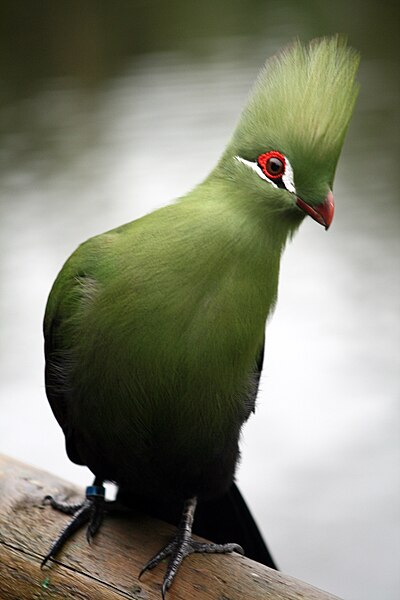
From Helen Briggs at the BBC:
The fossil’s weird features suggests it is the earliest known living relative not just of the turacos, but of cuckoos and bustards (large long-legged birds).
And the fact the remains were unearthed in North America shows the distribution of different birds around the globe would have been very different in the past.
…
This raises questions about how, when, and why the birds became restricted to tropical latitudes.
Dr Field said there are over 11,000 living species of bird today, and trying to understand how this incredible diversity is only possible “by appealing to what the fossil record tells us about how those evolutionary transitions have taken place”. More.
In this case, what the fossil record tells us poses a problem for biogeography (the distribution of life forms worldwide over time). At 52 million years ago, North America was thousands of kilometres from Africa. Did the birds migrate? Could they?
Gunter Bechly notes a number of instances at ENST where the biogeographical evidence that does not square well with the current evolutionary paradigm, for example:
Among the very diverse spider fauna of Australia there is one species that stands out: the tree trapdoor spider Moggridgea rainbowi, which only occurs on Kangaroo Island, but has its closest relatives of the same genus living in Africa. A phylogenomic study suggested that the Australian species separated from its African con-generic sister species about 2-16 million years ago, which is much later than the separation of the Australian and African continents around 95 million years ago. Therefore, it was recently proposed by Harrison et al. (2017) that large tarantulas rafted 6,000 miles across the wild Indian Ocean from Africa all the way to Australia (PLOS 2017), and not to the long coast of Western Australia but to a small island near Adelaide in South Australia. Professor Andrew Austin, the PhD supervisor of the publication’s lead author, Sophie Harrison, said in an interview, “At first thought, this does seem incredible” (University of Adelaide 2017). At first thought? I give it a second and third thought and still find it incredible. More.
This is actually an old but ignored problem, as Jonathan Wells noted in 2009:
Another example is freshwater crabs. Studied intensively by Italian biologist Giuseppe Colosi in the 1920s, these animals complete their life cycles exclusively in freshwater habitats and are incapable of surviving prolonged exposure to salt water. Today, very similar species are found in widely separated lakes and rivers in Central and South America, Africa, Madagascar, southern Europe, India, Asia and Australia. Fossil and molecular evidence indicates that these animals originated long after the continents separated, so their distribution is inconsistent with the vicariance hypothesis. Some biologists speculate that the crabs may have migrated by “transoceanic rafting” in hollow logs, but this seems unlikely given their inability to tolerate salt water. So neither vicariance nor migration provides a convincing explanation for the biogeography of these animals.37
An alternative explanation was suggested in the mid-twentieth century by Léon Croizat, a French biologist raised in Italy. Croizat found that Darwin’s theory did “not seem to agree at all with certain important facts of nature,” especially the facts of biogeography. Indeed, he concluded, “Darwinism is by now only a straitjacket… a thoroughly decrepit skin to hold new wine.” Croizat did not argue for independent acts of creation; instead, he proposed that in many cases a widespread primitive species was split into fragments, then its remnants evolved in parallel, in separate locations, into new species that were remarkably similar. Croizat called this process of parallel evolution “orthogenesis.” Neo-Darwinists such as Ernst Mayr, however, pointed out that there is no mechanism for orthogenesis, which implies–contrary to Darwinism–that evolution is guided in certain directions; so they rejected Croizat’s hypothesis.38More.
Here’s the paper:
Abstract: Background – Earth’s lower latitudes boast the majority of extant avian species-level and higher-order diversity, with many deeply diverging clades restricted to vestiges of Gondwana. However, palaeontological analyses reveal that many avian crown clades with restricted extant distributions had stem group relatives in very different parts of the world.
Results – Our phylogenetic analyses support the enigmatic fossil bird Foro panarium Olson 1992 from the early Eocene (Wasatchian) of Wyoming as a stem turaco (Neornithes: Pan-Musophagidae), a clade that is presently endemic to sub-Saharan Africa. Our analyses offer the first well-supported evidence for a stem musophagid (and therefore a useful fossil calibration for avian molecular divergence analyses), and reveal surprising new information on the early morphology and biogeography of this clade. Total-clade Musophagidae is identified as a potential participant in dispersal via the recently proposed ‘North American Gateway’ during the Palaeogene, and new biogeographic analyses illustrate the importance of the fossil record in revealing the complex historical biogeography of crown birds across geological timescales.
Conclusions – In the Palaeogene, total-clade Musophagidae was distributed well outside the range of crown Musophagidae in the present day. This observation is consistent with similar biogeographic observations for numerous other modern bird clades, illustrating shortcomings of historical biogeographic analyses that do not incorporate information from the avian fossil record.(open access) More. Pdf
See also: Darwinian just-so story: Some migratory birds do better with weak immune systems We don’t know, for example, that migration IS a good survival strategy for these birds; it might be the only one they can use—even if it leads, in the case of some species, to extinction. We should usually think of extinctions in terms of very long periods, much longer than human have been observing birds in scientific way and writing about them.
Nick Matzke’s research critiqued in Journal of BioGeography
and
Biogeography: Monkeys sailed the ocean blue